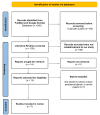Robotic Resection of an Ectopic Parathyroid Gland: A Systematic Review
- PMID: 39764345
- PMCID: PMC11701790
- DOI: 10.7759/cureus.75096
Robotic Resection of an Ectopic Parathyroid Gland: A Systematic Review
Abstract
Ectopic parathyroid glands result from abnormal migration during development. If not detected promptly, they can lead to persistent or recurrent primary hyperparathyroidism (pHPT). Inferior parathyroid glands are typically located in the anterior mediastinum, while superior parathyroid glands are often near the tracheoesophageal groove, both of which contribute to pHPT. Surgical management of pHPT often involves advanced techniques, with robotic parathyroidectomy using the da Vinci system emerging as an effective approach. This method offers comparable outcomes to traditional surgery, along with enhanced cosmetic results. This systematic review follows PRISMA (Preferred Reporting Items for Systematic Reviews and Meta-analyses) guidelines and an author-approved protocol to compare success rates, outcomes, and complications associated with robotic parathyroidectomy specifically for ectopic parathyroid glands. The authors conducted a thorough search of PubMed and Google Scholar using Medical Subject Headings (MeSH) terms such as "Robotic resection surgical techniques," "Endocrine surgery," and "Ectopic parathyroid gland." After screening 200 papers, seven studies were selected based on relevance and methodological rigour. Each study's quality and risk of bias were assessed using the Risk of Bias in Non-randomised Studies of Interventions (ROBINS-I) tool for non-randomised studies, and findings were visualised using the Risk of Bias Visualisation (ROBVIS) tool to ensure systematic evaluation of potential biases, such as confounding and selection. This review addresses a gap in the literature by focusing on robotic-assisted surgery for ectopic parathyroid glands, highlighting its advantages, including enhanced visualisation and reduced surgical trauma in challenging anatomical sites. These benefits result in shorter hospital stays, fewer perioperative complications, and improved cosmetic outcomes. However, the broader adoption of robotic surgery requires significant investment in training and equipment, and careful patient selection is essential to minimise complications such as brachial plexus injury. Robotic parathyroidectomy demonstrates favourable patient outcomes in comparison to traditional methods, particularly for difficult-to-access ectopic glands. However, ongoing research is needed to further optimise surgical efficacy, especially through the integration of histopathological and intraoperative monitoring. Future randomised controlled trials (RCTs) should focus on long-term outcomes, cost-effectiveness, and comparing robotic surgery to traditional methods in terms of both clinical success and patient quality of life.
Keywords: da vinci robotic system; ectopic parathyroid glands; primary hyperparathyroidism; robotic parathyroidectomy; systematic review.
Copyright © 2024, Khanom et al.
Conflict of interest statement
Conflicts of interest: In compliance with the ICMJE uniform disclosure form, all authors declare the following: Payment/services info: All authors have declared that no financial support was received from any organization for the submitted work. Financial relationships: All authors have declared that they have no financial relationships at present or within the previous three years with any organizations that might have an interest in the submitted work. Other relationships: All authors have declared that there are no other relationships or activities that could appear to have influenced the submitted work.
Figures


Similar articles
-
Robotic-assisted minimally invasive surgery for gynecologic and urologic oncology: an evidence-based analysis.Ont Health Technol Assess Ser. 2010;10(27):1-118. Epub 2010 Dec 1. Ont Health Technol Assess Ser. 2010. PMID: 23074405 Free PMC article.
-
Resection of ectopic mediastinal parathyroid glands with the da Vinci robotic system.Br J Surg. 2010 Mar;97(3):337-43. doi: 10.1002/bjs.6905. Br J Surg. 2010. PMID: 20095017
-
Minimally invasive parathyroidectomy guided by intraoperative parathyroid hormone monitoring (IOPTH) and preoperative imaging versus bilateral neck exploration for primary hyperparathyroidism in adults.Cochrane Database Syst Rev. 2020 Oct 21;10(10):CD010787. doi: 10.1002/14651858.CD010787.pub2. Cochrane Database Syst Rev. 2020. PMID: 33085088 Free PMC article.
-
[Re-operation treatment in uremic patients complicated with persistent secondary hyperparathyroidism after parathyroidectomy with autotransplantation].Lin Chuang Er Bi Yan Hou Tou Jing Wai Ke Za Zhi. 2018 Jan 20;32(2):142-147. doi: 10.13201/j.issn.1001-1781.2018.02.016. Lin Chuang Er Bi Yan Hou Tou Jing Wai Ke Za Zhi. 2018. PMID: 29757564 Chinese.
-
Endoscopic and robotic parathyroidectomy in patients with primary hyperparathyroidism.Gland Surg. 2016 Jun;5(3):352-60. doi: 10.21037/gs.2016.01.06. Gland Surg. 2016. PMID: 27294044 Free PMC article. Review.
Cited by
-
Surgical Management of Mediastinal Ectopic Parathyroids.J Pers Med. 2025 Jun 30;15(7):276. doi: 10.3390/jpm15070276. J Pers Med. 2025. PMID: 40710393 Free PMC article. Review.
References
-
- Ectopic parathyroid glands and their anatomical, clinical and surgical implications. Noussios G, Anagnostis P, Natsis K. https://sci-hub.yncjkj.com/10.1055/s-0032-1327628. Exp Clin Endocrinol Diabetes. 2012;120:604–610. - PubMed
-
- Robotic parathyroid surgery: current perspectives and future considerations. Arora A, Garas G, Tolley N. https://karger.com/orl/article/80/3-4/195/261904/Robotic-Parathyroid-Sur.... ORL J Otorhinolaryngol Relat Spec. 2018;80:195–203. - PubMed
-
- Diagnosis and management of primary hyperparathyroidism. Pallan S, Rahman MO, Khan AA. https://sci-hub.yncjkj.com/10.1136/bmj.e1013 BMJ. 2012;344:0. - PubMed
-
- Primary hyperparathyroidism in the 1990s. Choice of surgical procedures for this disease. Kaplan EL, Yashiro T, Salti G. https://pubmed.ncbi.nlm.nih.gov/1558410/ Ann Surg. 1992;215:300–317. - PMC - PubMed
-
- Long-term outcome in patients with primary hyperparathyroidism who underwent minimally invasive parathyroidectomy. Venkat R, Kouniavsky G, Tufano RP, Schneider EB, Dackiw AP, Zeiger MA. https://pubmed.ncbi.nlm.nih.gov/22089919/ World J Surg. 2012;36:55–60. - PubMed
Publication types
LinkOut - more resources
Full Text Sources
Miscellaneous
